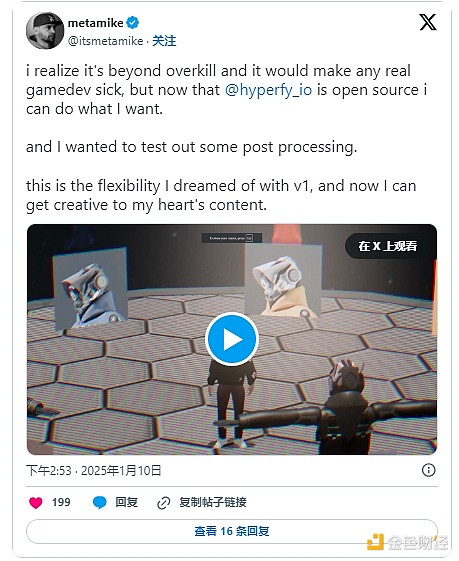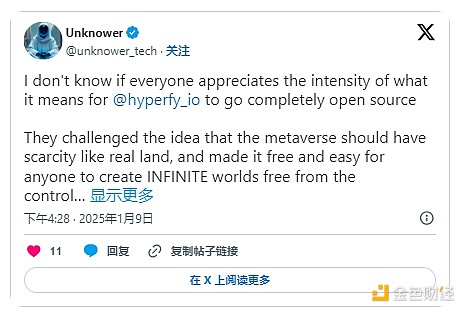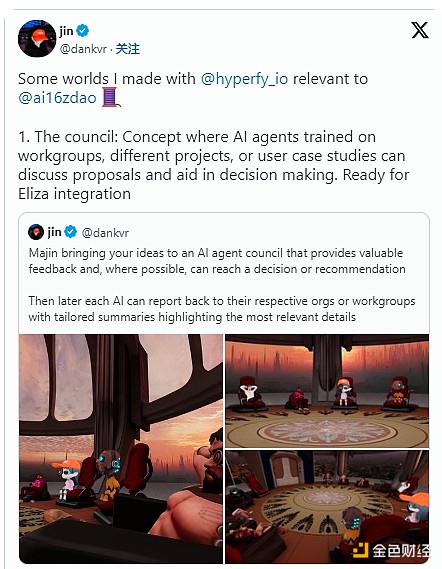Author: William M. Peaster, Bankless; Translator: Baishui, Golden Finance
This week, I wrote about Eliza Daydreams and the Wayfinder proxy framework, which got me thinking about Hyperfy.
I’m interested in gaming infrastructure like Eliza, Wayfinder, and more, especially fully on-chain games.
But the possibilities of these systems extend beyond pure gameplay to include virtual worlds like Hyperfy, a browser-based VR platform for any device.
That said, Hyperfy was in the news this week for a few reasons: elizaOS just added support, and the Hyperfy team just open-sourced their engine and launched $HYPER with a new, more accessible platform approach.
That last point — the more accessible platform approach — I want to dig a little deeper here because I think it’s an example of the “right way” and a reflection of the trend toward metaverse experiences.
Why Hyperfy v2 is so important
In Hyperfy v1, customizable virtual worlds could be minted as NFTs for ETH.
This feature has been removed from the v2 system, so now anyone can create a Hyperfy virtual world at any time for free. We've seen many people testing this newfound freedom.

No-code tools are also coming soon, which will make building here even easier. But my favorite thing about the v2 shift is that it moves toward the prospect of abundance when it comes to digital land.
I like this move away from artificial scarcity because it rejects the pitfalls of the past.
In fact, there’s a serious problem with the 2021 metaverse boom, and that’s the death spiral of land speculation.
This phenomenon isn’t unique to NFTs, it’s been observed for decades in virtual worlds like Second Life and games like EVE Online and Final Fantasy.
These death spirals occur when projects make digital space behave too much like physical land—scarce and very valuable, leading to a speculative bubble that eventually bursts.

So in going free and open, Hyperfy gives itself the best chance to thrive and attract an empowered, happy, and vibrant community that can do what they want, how they want, when they want, and with whatever assets and NFTs they want to bring.
This pushes the problem of artificial scarcity to the user, who can still choose to place tokens in their world if they want.
But it’s for the users to decide. If artificial scarcity is implemented at the platform level without using counter-mechanisms like Metaverse Land Taxes and Citizen Dividends, then stagnation or pain will set in.
So yes, it is indeed refreshing to see projects like Hyperfy decisively move away from the mistakes we have seen other teams make over the years.
There is no inherent limit to virtual land, and more free virtual land can always be created. Hyperfy is on the right side of this paradigm right now, and I think this dynamic can greatly help unlock its potential over time.
Then throw into the mix advances like AI agents and Midjourney’s upcoming Holodeck (which is able to generate 3D space on demand in real time), and the future looks endless in terms of new excitement to build, populate, and enjoy in virtual worlds.
These advances and promises are setting the stage for a new wave of interest and experimentation in virtual worlds, which will surely trickle down to other areas like DAOs, DeFi, and more.

Just something to think about, right.
If you want to try Hyperfy for yourself, a great place to start is to attend The WIP, a metaverse meetup that has been running since 2019 and is live on Hyperfy every Thursday. You’ll meet some of the best in crypto, and from an alpha perspective, it’s definitely worth your time.
Now, don’t lose sight of the forest for the trees. As Vance Spencer once said, “The metaverse narrative [remains] the broadest of all narratives, the superset of all other crypto narratives.”
 Joy
Joy







